How to properly transplant cucumbers to another place and is it possible
Among summer residents, there is an opinion that transplanting cucumbers is a waste of time, since the plants will die or the cucumbers will adapt for a long time in a new place. It's a delusion. Consider how to transplant your cucumbers to another place for the procedure to be successful.
Content
- 1 Terms of transplanting cucumbers and soil
- 2 Preparing the soil for transplanting
- 3 We grow cucumber seedlings correctly
- 4 Transplant tips
- 5 If the cucumbers have grown thickly
- 6 Post-transplant care
- 7 Pests attacked cucumbers
- 8 Signs of disease on cucumber leaves
- 9 Summer residents about transplanting cucumbers
- 10 Conclusion
Terms of transplanting cucumbers and soil
These two parameters - the period of transplanting cucumbers and the degree of readiness of the soil - are interrelated, and the success when changing the place largely depends on them. It is necessary to take into account the age of the cucumber seedlings. By the time the cucumbers are planted in open ground, at least 20 days should have passed from the emergence of seedlings, and the age of 25 days is considered optimal for seedlings.
Adding five days for pecking seeds, we get the time before transshipment of cucumber seedlings to a new place:
- to the greenhouse;
- in open ground;
- under a temporary shelter.
The soil on the future ridge for cucumbers in the open field should ripen - warm up to a temperature of 15 ° C. You need to measure the temperature in the morning, and not on the soil surface, but at a depth of 15 - 20 cm - where the roots of a young plant will be. Special soil thermometers are available for sale.
The roots of cucumbers, planted in cold ground, do not absorb nutrients in the required volume, the plant stops growing, lags behind in development. Immunity is weakened, the likelihood of disease in cucumber seedlings increases.
Possible diseases of cucumbers in the open field:
- ascochitis;
- bacteriosis;
- cladosporiosis;
- root rot;
- mosaic;
- powdery mildew;
- fusarium wilting.
In addition to soil temperature, the chemical composition, structure and acidity of the earth are important. Transplanting cucumbers into heavy, dense soil is rarely successful.
Preparing the soil for transplanting
Already at the 20th of April, you can plant seedlings in a greenhouse, after May 20 - in the ground under arcs, in June - in open ground. For any planting option, prepare the ridge in advance.
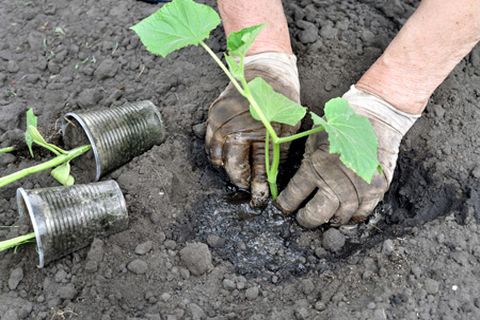
It is imperative to introduce organic matter (compost, humus) into the soil for digging. Organic matter will not only enrich the soil with nutrients, but also improve its structure. Peat increases soil looseness, river sand is introduced into heavy loamy soil. The acidity is controlled by the addition of ash, chalk or dolomite flour.
According to the norms indicated on the package, when digging the soil for cucumbers, scatter fertilizers over the area of the ridge:
- urea;
- superphosphate;
- potassium nitrate.
Water the ridge well. You can use any biological product such as Baikal Em1. The use of biological products accelerates the reproduction of microorganisms necessary for the plant, which will have a positive effect on cucumber seedlings.
Shed the earth with a solution of phytosporin.Use fungicide if there were plants infected with fungus in the previous season. There will be no problems with preparing the drug. The package contains detailed instructions for using the drug.
We grow cucumber seedlings correctly
Reproduction by seedlings accelerates the fruiting of cucumbers in the open field and in the greenhouse. For greenhouses, you need to purchase varieties (hybrids) that do not require pollination - parthenocarpic, any are suitable for the street:

- bee-pollinated;
- self-pollinated;
- not requiring pollination.
Sort out cucumber seeds not processed by the manufacturer before planting, discard damaged ones, whole, without visible defects, soak in water. Reject the seeds that have surfaced, place the rest in a pink solution of potassium permanganate for 15 minutes. Seed dressing kills fungi and other infections.
The seeds can be wrapped in a damp cloth, placed in a plastic container, placed near the battery. Plant the hatched seeds in peat pots filled with loose, fertile soil, water. To accelerate the germination of the container, cover it with PVC foil and place in a warm place. Cucumber sprouts will appear in 5 - 7 days at an air temperature of 25 - 28 ° C.
Transplant tips
A good grower always has a recommended planting pattern on a bag of cucumber seeds. The scheme must be adhered to when forming the landing holes. In general, place them no closer than 35 cm from each other. Maintain a row spacing of 50 to 70 cm. According to summer residents, if cucumbers are planted less often, the yield is higher from one plant.
When transferring plants from the container to the planting hole, do not damage the earthen ball and do not deepen it too much. Cucumber cotyledons should be 1 to 2 cm above ground level.
Pour the wells with warm water and sprinkle with humus - a 2 to 3 cm layer will be enough. When it gets cold, mulch protects cucumber roots from cold, in the heat will slow down the evaporation of moisture from the soil.
If the cucumbers have grown thickly
Seed germination is never 100%. When sowing cucumbers with dry or sprouted seeds, put from 3 to 5 cucumber seeds in the hole. The number of seeds depends on the size of the holes. If the seeds are successful, with good germination, you will have to decide how to thin the seedlings.
Thinning of cucumbers is necessary within 20 - 25 days. The densely planted cucumbers, growing up, will shade each other. This will affect the future yield of cucumbers and the health of cucumber lashes.
You can thin out by pinching weaker plants or transferring excess bushes to another ridge. Do not delay the transplant, because during flowering, the bushes are harder to transfer to a new place. Work on transplanting into open ground should be carried out in the evening.

Find a convenient scoop for transplanting cucumbers, preferably a large one. Dig a hole 25 * 25 cm. Try to dig up the plant along with a large clod of earth, carefully transfer the cucumber to a new place. Sprinkle with earth, do not press hard into the root area, water the soil. Under the influence of water, the loose earth itself will adhere tightly to the roots of the cucumber.
Post-transplant care
When 10 - 12 days have passed after transplanting cucumbers, the first fertilization is carried out into the soil. For watering 1 m² of soil with plants in a 10 liter bucket we will dissolve 1 tbsp. l. urea and 2 tbsp. l superphosphate, the time for the second fertilization will come when the cucumbers begin to bloom.
Fertilizers are taken for the same volume of water:
- 40 g superphosphate;
- 30 g of ammonium nitrate;
- 20 g of potassium nitrate.
The active formation of ovaries and fruits began in cucumbers. This means it's time to feed a third time. Dissolve 2 tbsp in a bucket of water. l. potassium nitrate and water each plant.
Many modern hybrids need pruning to maintain normal fruiting. The pruning scheme for cucumbers depends on the variety.In bee-pollinated varieties, pinch the crown of the central conductor of the cucumber, provoking the growth of lateral shoots in the cucumber.
In parthenocarpic cucumbers with a bunch type of fruiting, the central conductor is not touched. Remove flowers from cucumbers and ovaries from the lower 4 - 5 leaf axils. The next side shoots are left, but they are pinched over the first cucumber ovaries.
You need a trellis if you are planting cucumbers in a greenhouse. Support will not hurt for cucumbers in the open field. As the cucumber lashes grow back, you need to attach them to the wire (mesh) using soft knits or twine.
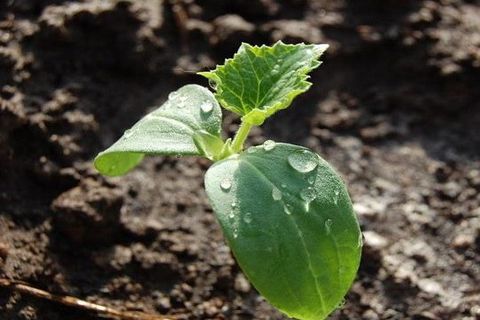
The main point of caring for cucumbers is watering. It is carried out regularly, at least 1 time per week at the beginning of the growth of cucumbers and 1 time in 3 days - during the appearance of flowers and fruits in cucumbers. The frequency of watering cucumbers can be reduced only during a cold snap.
In cold ground, the absorption of nutrients and moisture is slowed down. Remember that cold water is prohibited, only warm and settled. Watering cucumbers should be carried out only in the morning, spending at least 10 liters of water per 1 m² of soil.
Weed-free is rare. Usually all summer in the beds, despite the efforts of summer residents, weeds climb, which not only takes away nutrients from cucumbers, but also contributes to the spread of diseases. Keeping the ridges clean is an important duty of the summer resident.
Pests attacked cucumbers
The question of what to do if pests (aphids, thrips, thrips, spider mites) attacked cucumber whips often worries gardeners.
You can do with folk remedies if you notice the problem at the very beginning and the insects have not yet begun to multiply exponentially. Until the lashes have reached a great length, they can be washed by drawing water into a basin and passing a soft sponge over the plants.
You can scare off aphids and other pests from cucumbers with soapy water. Liquid soap (antibacterial) is suitable for preparing the solution. For 1 liter, 2 tbsp is enough. l. The resulting liquid must be sprayed on all plants.
Harmful insects do not like the smell of tobacco, bitter pepper and garlic. To obtain a 3-liter tin of infusion, you need 0.5 kg of pure garlic. The process of preparing a bitter infusion takes a little less than a week (5 days).
The following popular recipe for pests may come in handy: 5 parts of Coca-Cola, 1 part of water. This is not a joke: Coca-Cola helps against insects. Spray the lower parts of the leaves of the cucumber with an aqueous solution of "Coca-Cola".
The treatment of plants with any means will have to be repeated several times. At least, cucumber processing is carried out once a week, in case of severe plant infection - 2 times a week.
Signs of disease on cucumber leaves
In the middle and at the end of summer, a picture is often found - on the leaves of the cucumber there are white spots that darken over time or dried leaves and bitter fruits. These are symptoms of a common disease - powdery mildew.
Without a summer resident's struggle with a fungal infection, the cucumber will gradually decay and stop bearing fruit. To prevent this from happening, you need to process the leaves and stems of plants when the listed symptoms appear with a solution of soda (4%). You can use the drug "Baktofit". Reviews of the drug are positive.
Fusarium wilting is a danger to cucumbers. Up to 50% of the crop may die. Especially often this disease affects dacha plantings with cucumbers in the southern regions of the country and among summer residents who grow cucumbers in greenhouses. Sick plants are recommended to be treated with the "Privikur" preparation or to be mercilessly pulled out and burned.
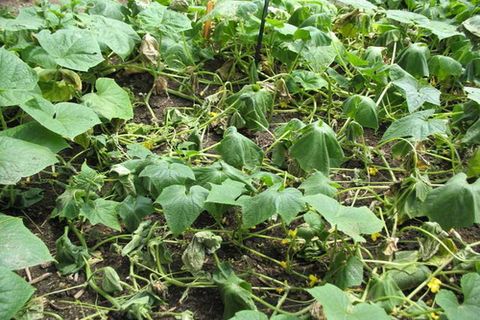
You can prepare a fashionable folk recipe for all cucumber diseases. To prepare it, you need 1 liter of milk (sour milk can be used), 35 drops of iodine and a tablespoon of grated soap. Plants are sprayed with this preparation in the morning, until the sun has risen.
Summer residents about transplanting cucumbers
Reviews of the cucumber transplant procedure are ambiguous.
Alina, 59 years old, Moscow:
“I prefer to sow with dry seeds directly on the beds. In my experience of many years, replanting cucumbers is a troublesome business. After transplantation, cucumbers get sick much more often, they take root for a long time. It is easier if the seedlings are small, with 2 - 3 leaves. It is worse if the cucumbers are stretched out and gain color. After transplanting cucumbers, flowers and ovaries will still have to be cut off. True, they themselves can crumble from stress. "
Andrey, 44 years old, Kostroma:
“I don’t have a question whether it is possible to transplant cucumbers if they have sprouted too often. I always do it successfully. In rare cases, plants do not take root. I am not wise with technology. I do it in cloudy weather: I dig out cucumbers with a large clod of earth and immediately plant them in a garden in another place. I cover the cucumbers in the garden with cardboard boxes for 3 days. Plants adapt quickly. "
Alexey, 67 years old, Voronezh:
“The shoots of cucumbers are uneven. In one half of the garden it was completely empty, and on the other half all the cucumbers had come out. Until this year, I did not transplant cucumbers in the open field, so I doubted, but I planted cucumbers evenly throughout the entire ridge. The transplanted plants at first noticeably lagged behind in development, but then the cucumbers leveled off and gave a good harvest of cucumbers. I processed the planting of cucumber once with "Epin", then a week later I sprinkled the cucumbers with milk and iodine. "
Conclusion
Regarding the transplantation of cucumber seedlings - how many summer residents, so many opinions. Whether the resulting harvest will justify the expenditure of time and effort on growing cucumber seedlings can be found only in the fall. But it's worth a try, because early cucumbers are tasty and healthy.
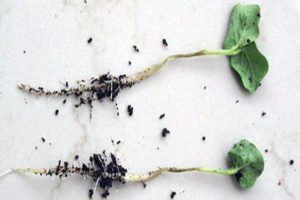
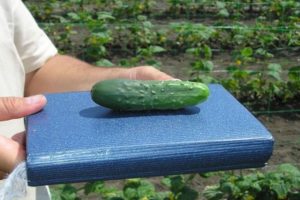




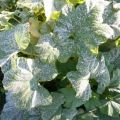
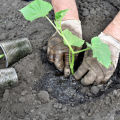


Of course, you can transplant cucumbers, there is nothing special about it, basically it does not take much time and effort. The soil needs to be fertilized before replanting, I always buy BioGrow. I bought it in this store.